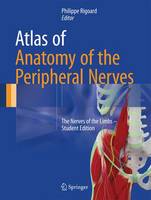(To see other currencies, click on price)
MORE ABOUT THIS BOOK
Main description:
This innovative atlas focuses on peripheral nerves and provides a brand new approach compared to regular anatomy books. Using a modern 3D approach, it offers an alternative to conventional anatomical structures. It reviews all the anatomy and the morphology of these structures from an original point of view. In these three-dimensional diagrams, as well as in the watercolor drawings enhanced with a 3D inlay, each type of nerve is depicted in a minute detail. The atlas simplifies the anatomy and make it easy and understandable by allowing readers to develop a mental "real-time 3D GPS". The integration of MRI sections related to the drawings and the descriptions of the main nerve injuries provide medical students with a flexible but effective transition to the radiological interpretation and furthers the clinical learning process. After a detailed evaluation of the morphofunctional anatomy of the peripheral nerves, the authors present a collection of relevant data on neuromuscular transmission, both from classical and recent literature, ranging from the central and peripheral nervous system to the effector muscle.
This information offers a basis for understanding the physiology, the pathology, and the repair prospects of peripheral nerves from a purely theoretical point of view.The book is divided into three main parts: - Fundamental notions: from immunohistochemistry to limb innervation- The upper limb: the brachial plexus and related peripheral nerves- The lower limb: the lumbosacral plexus and related peripheral nerves This atlas also features 261 outstanding full-colour 2D and 3D illustrations. Each picture has been designed in 2D and 3D with a combination of the original editor's personal drawings/paintings and 3D-modeling tools. This book is a valuable resource for anyone studying medicine, anaesthesiology, neurosurgery, spine surgery, pain, radiology or rheumatology and is also of high interest to the whole medical community in general.
Contents:
LIST OF CONTRIBUTORSFOREWORDACKNOWLEDGEMENTSANATOMY PREAMBLE ABOUT THIS BOOKCONTENTS Part I : Morphological and functional anatomy of the peripheral nerve1. The normal nerve 1.1. General organisation of the peripheral nerve1.2. The nerve's structure and physiology 1.3. Schwann cell and myelinisation1.4. Mechanical properties of the nerves1.5. Vascularization of the peripheral nerve 1.6. Neuromuscular junction and transmission<1.7. Main mechanisms of synaptic formation 2. The injured nerve2.1. Physiology of the damaged nerve2.2. Nerve degeneration2.3. Mechanisms of neuronal reparation3. The Plexus 3.1. Data issued from embryology3.2. Development of the innervation of limbs3.3. Innervation of the limbs in adults3.4. The notion of plexus Part II: Nerves of the upper limb 1. The brachial plexus1.1. Morphological data 1.2. The brachial plexus' relations 1.2.1 At the supraclavicular level1.2.2 At the infraclavicular level2. The axillary nerve2.1. Morphological data2.1.1 Origin2.1.2 Path2.1.3 Neurovascular relation2.1.4 Collateral branches2.1.5 Terminal branches2.1.6 Motor function 2.1.7 Sensitive function2.1.8 Anastomoses2.2. Pathology2.2.1 Etiology2.2.2 Clinical significance 2.2.3 Clinical forms2.2.4 Complementary examinations2.2.5 Treatment3. The musculocutaneous nerve3.1. Morphological data3.1.1 Origin3.1.2 Path3.1.3 Neurovascular relation3.1.4 Collateral branches3.1.5 Terminal branches3.1.6 Motor function 3.1.7 Sensitive function3.1.8 Anastomoses3.2 Pathology 3.2.1 Etiology3.2.2 Clinical significance 3.2.3 Clinical forms3.2.4 Complementary examinations3.2.5 Treatment4 The radial nerve4.1 Morphological data 4.1.1 Origin4.1.2 Path4.1.3 Neurovascular relation4.1.4 Collateral branches4.1.5 Terminal branches4.1.6 Motor function 4.1.7 Sensitive function4.1.8 Anastomoses4.2 Pathology 4.2.1 Posterior interosseous nerve syndrome4.2.2 Etiology4.2.3 Clinical signs4.2.4 Clinical forms4.2.5 Complementary examinations4.2.6 Treatment5 The median nerve5.1 Morphological data 5.1.1 Origin5.1.2 Path5.1.3 Neurovascular relation5.1.4 Collateral branches5.1.5 Terminal branches5.1.6 Motor function 5.1.7 Sensitive function5.1.8 Anastomoses5.2 Pathology 5.2.1 Anterior interosseous nerve syndrome5.2.2 Etiology5.2.3 Clinical significance5.2.4 Clinical forms5.2.5 Complementary examinations5.2.6 Treatment5.3 Carpal tunnel syndrome5.3.1 Clinical signs5.3.2 Differential diagnosis5.3.3 Treatment 6 The ulnar nerve6.1 Morphological data 6.1.1 Origin6.1.2 Path6.1.3 Neurovascular relations6.1.4 Collateral branches6.1.5 Terminal branches6.1.6 Motor function 6.1.7 Sensitive function5.1.8 Anastomoses6.2 Pathology 6.2.1 Cubital tunnel syndrome6.2.2 Etiology6.2.3 Clinical significance6.2.4 Clinical forms6.2.5 Complementary examinations6.2.6 Treatment6.3 Ulnar tunnel syndrome (Guyon's canal)6.3.1 Etiology6.3.2 Clinical signs6.3.3 Clinical forms6.3.4 Complementary examinations6.3.5 Treatment 7 The suprascapular nerve7.1 Morphological data 7.1.1 Origin7.1.2 Path7.1.3 Neurovascular relations7.1.4 Collateral branches7.1.5 Terminal branches7.1.6 Motor function 7.2 Pathologies 7.2.1 Etiology7.2.2 Clinical significance7.2.3 Complementary examinations7.2.4 Treatment8 The long thoracic nerve8.1 Morphological data 8.1.1 Origin8.1.2 Path8.1.3 Neurovascular relations8.1.4 Terminal branches8.1.5 Motor function 8.2 Pathologies8.2.1 Etiology8.2.2 Clinical significance8.2.3 Treatment 9 BibliographyPart III: Nerves of the lower limb1. The lumbosacral plexus1.1. Morphological data1.1.1. The lumbar plexus1.2. Morphological data1.2.1. The sacral plexus1.3. Relationship between the lumbar and sacral plexuses1.4. Overview diagrams of the lower limb plexuses2. The obturator nerve2.1. Morphological data2.1.1. Origin2.1.2. Path2.1.3. Neurovascular relations2.1.4. Collateral branches2.1.5. Terminal branches2.1.6. Motor function 2.1.7. Sensitive function2.1.8. Anastomoses2.2. Pathology 2.2.1. Obturator neuralgia2.2.2. Etiology2.2.3. Clinical significance2.2.4. Complementary examinations2.2.5. Treatment3. The femoral nerve 3.1. Morphological data3.1.1. Origin3.1.2. Path3.1.3. Neurovascular relations3.1.4. Collateral branches3.1.5. Terminal branches3.1.6. Motor function 3.1.7. Sensitive function3.1.8. Anastomoses3.2. Pathology 3.2.1. Femoral nerve syndrome or Femoral Neuralgia3.2.2. Etiology3.2.3. Clinical significance3.2.4. Complementary examinations3.2.5. Treatment4. The sciatic nerve4.1. Morphological data4.1.1. Origin4.1.2. Path4.1.3. Neurovascular relations4.1.4. Collateral branches4.1.5. Terminal branches4.1.6. Motor function 4.1.7. Sensitive function4.1.8. Anastomoses4.2. Pathology 4.2.1. Etiology4.2.2. Clinical significance4.2.3. Clinical forms4.2.4. Complementary examinations4.2.5. Treatment5. The tibial nerve5.1. Morphological data5.1.1. Origin5.1.2. Path5.1.3. Neurovascular relations5.1.4. Collateral branches5.1.5. Terminal branches5.1.6. Motor function 5.1.7. Sensitive function5.1.8. Anastomoses5.2. Pathology 5.2.1. Soleus syndrome 5.2.2. Etiology5.2.3. Clinical significance5.2.4. Complementary examinations5.2.5. Treatment5.3. Tarsal tunnel syndrome 5.3.1. Etiology5.3.2. Clinical significance5.3.3. Clinical forms5.3.4. Complementary examinations5.3.5. Treatment6. The common fibular nerve6.1. Morphological data"div>6.1.1. Origin6.1.2. Path6.1.3. Neurovascular relations6.1.4. Collateral branches6.1.5. Terminal branches6.1.6. Motor function 6.1.7. Sensitive function6.1.8. Anastomoses6.2. Pathology 6.2.1. Fibular nerve injury6.2.2. Etiology6.2.3. Clinical significance6.2.4. Clinical forms6.2.5. Complementary examinations6.2.6. Treatment7. The lateral femoral cutaneous nerve7.1. Morphological data7.1.1. Origin7.1.2. Path7.1.3. Neurovascular relations7.1.4. Terminal branches7.1.5. Sensitive function7.2. Pathology 7.2.1. Meralgia paraesthetica7.2.2. Etiology7.2.3. Clinical significance8. Other nerves8.1. Iliohypogastric nerve8.1.1 Morphological data8.2. Ilioinguinal nerve8.2.1 Morphological data8.3. Pathology8.3.1 Entrapment neuropathies of the ilioinguinal nerve and of the hypogastric nerve8.3.2 Etiology8.3.3 Clinical significance8.3.4 Clinical forms8.3.5 Treatment 9. General views10. Bibliography INDEX
PRODUCT DETAILS
Publisher: Springer (Springer International Publishing AG)
Publication date: July, 2017
Pages: None
Weight: 652g
Availability: Available
Subcategories: Anaesthetics and Pain, Anatomy, Neurosurgery, Orthopaedics and Fractures, Rheumatology, Surgical Techniques

